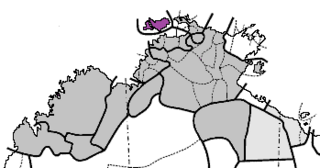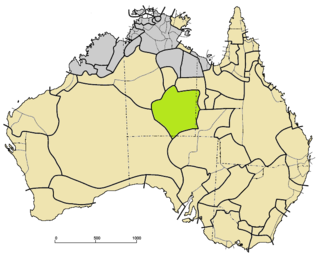Related Research Articles

The Indigenous languages of Australia number in the hundreds, the precise number being quite uncertain, although there is a range of estimates from a minimum of around 250 up to possibly 363. The Indigenous languages of Australia comprise numerous language families and isolates, perhaps as many as 13, spoken by the Indigenous peoples of mainland Australia and a few nearby islands. The relationships between the language families are not clear at present although there are proposals to link some into larger groupings. Despite this uncertainty, the Indigenous Australian languages are collectively covered by the technical term "Australian languages", or the "Australian family".
Guugu Yimithirr, also rendered Guugu Yimidhirr, Guguyimidjir, and many other spellings, is an Australian Aboriginal language, the traditional language of the Guugu Yimithirr people of Far North Queensland. It belongs to the Pama-Nyungan language family. Most of the speakers today live at the community of Hope Vale, about 46 kilometres (29 mi) from Cooktown. However, as of June 2020 only about half of the Guugu Yimithirr nation speak the language. As such, efforts are being made to teach it to children. Guugu Yimithirr is the source language of the word kangaroo.

The Warlpiri language is spoken by close to 3,000 of the Warlpiri people from the Tanami Desert, northwest of Alice Springs, Central Australia. It is one of the Ngarrkic languages of the large Pama–Nyungan family and is one of the largest Aboriginal languages in Australia in terms of number of speakers. One of the most well-known terms for The Dreaming, Jukurrpa, derives from Warlpiri.
Badimaya is an Australian Aboriginal language. It is a member of the Kartu subgroup of the Pama–Nyungan family, spoken by the Badimaya people of the Mid West region of Western Australia.

Tiwi is an Australian Aboriginal language spoken by the Tiwi people on the Tiwi Islands, within sight of the coast of northern Australia. It is one of about 10% of Australian languages still being frequently learned by children.

Gaagudju is an extinct Australian Aboriginal language formerly spoken in the environs of Kakadu National Park, in Arnhem Land, Northern Territory, Australia.

Giimbiyu is an extinct Aboriginal Australian language isolate once spoken by the Giimbiyu people of northern Australia.
Yir-Yoront was a Paman language spoken in two settlements, Kowanyama and Pormpuraaw on the southwestern part of the Cape York Peninsula, Queensland in Australia, by the Yir-Yoront people. In 1991 only 15 speakers remained, with the rest of the Yir-Yoront people speaking English or even Kuuk Thaayorre as many speakers of Yir-Yoront apparently are using Kuuk Thaayorre in daily conversation. At present it is thought to be extinct. There are two sister dialects, Yir-Yoront proper and Yirrk-Thangalkl, which are very close. The shared name Yir is sometimes used for both taken together.

Arrernte or Aranda or sometimes referred to as Upper Arrernte, is a dialect cluster in the Arandic language group spoken in parts of the Northern Territory, Australia, by the Arrernte people. Other spelling variations are Arunta or Arrarnta, and all of the dialects have multiple other names.
Wambaya is a Non-Pama-Nyungan West Barkly Australian language of the Mirndi language group that is spoken in the Barkly Tableland of the Northern Territory, Australia. Wambaya and the other members of the West Barkly languages are somewhat unusual in that they are suffixing languages, unlike most Non-Pama-Nyungan languages which are prefixing.
Wik-Ngathan, or Wik-Iinjtjenj (Wik-Iinychanya), is a Paman language spoken on the Cape York Peninsula of Queensland, Australia, by the Wik-Ngathan people. It is closely related to the other Wik-Ngathan language, Wik-Ngatharr and more distantly to the other Wik languages. In 1981 there were 130 speakers.
Jaminjung is a moribund Australian language spoken around the Victoria River in the Northern Territory of Australia. There seems to be a steady increase in the number of speakers of the language with very few people speaking the language in 1967, about 30 speakers in 1991, and between 50 and 150 speakers in 2000.
Gurr-goni, also spelled Guragone, Gorogone, Gun-Guragone, Gunagoragone, Gungorogone, Gurrogone, Gutjertabia, is an Australian Aboriginal language spoken in Arnhem Land. There were about 60 speakers in 2011, all trilingual in Burarra or Kuninjku.
The Burarra language is an Australian Aboriginal language spoken by the Burarra people of Arnhem Land. It has several dialects.
Wadjiginy, also known as Wagaydy (Wogait) and Batjamalh, is an Australian Aboriginal language. Apart from being closely related to Kandjerramalh, it is not known to be related to any other language, though it has borrowed grammatical and lexical material from neighboring Northern Daly languages.
Mangarrayi is an Australian language spoken in the Northern Territory. Its classification is uncertain. Margaret Sharpe originally sought to record the language but turned to the study of Alawa after the station owner where her informants lived denied her access, having tired of the presence of researchers on the property.

Bunuba is an Australian Aboriginal language spoken by some 41 older Bunuba adults, most of whom live in Junjuwa, an Aboriginal community in Fitzroy Crossing in Western Australia. Bunuba is not related to the Pama-Nyungan language family that spans the majority of Australia; however, it is a relative of Guniyandi. Both are subgroups of the Bunuban language family. Bunuba consists of two dialects, 'light' and 'heavy' Bunuba.
Kukatj, also rendered Gugadj, is an extinct Paman language of the Cape York Peninsula, Queensland, Australia. The name Kalibamu has also been assigned to it, although this may be a separate dialect. It is spoken by the Kukatj people. A single speaker was last recorded in 1975.

Kaytetye is an Australian Aboriginal language spoken in the Northern Territory north of Alice Springs by the Kaytetye people, who live around Barrow Creek and Tennant Creek. It belongs to the Arandic subgroup of the Pama-Nyungan languages and is related to Alyawarra, which is one of the Upper Arrernte dialects. It has an unusual phonology and there are no known dialects.

The Macro-Gunwinyguan languages, also called Arnhem or Gunwinyguan, are a family of Australian Aboriginal languages spoken across eastern Arnhem Land in northern Australia. Their relationship has been demonstrated through shared morphology in their verbal inflections.
References
- ↑ Australian Bureau of Statistics (2021). "Cultural diversity: Census" . Retrieved 13 October 2022.
- ↑ N92 Alawa at the Australian Indigenous Languages Database, Australian Institute of Aboriginal and Torres Strait Islander Studies
- ↑ "Ethnologue: Alawa". Ethnologue.
- 1 2 3 Sharpe, Margaret C (1972). Alawa Phonology and Grammar . Canberra: Australian Institute for Aboriginal Studies.
- ↑ Capell, Arthur. 1941–1942, 1942–1943. Languages of Arnhem Land, North Australia. Oceania 12: 364–392, 13: 24–51.